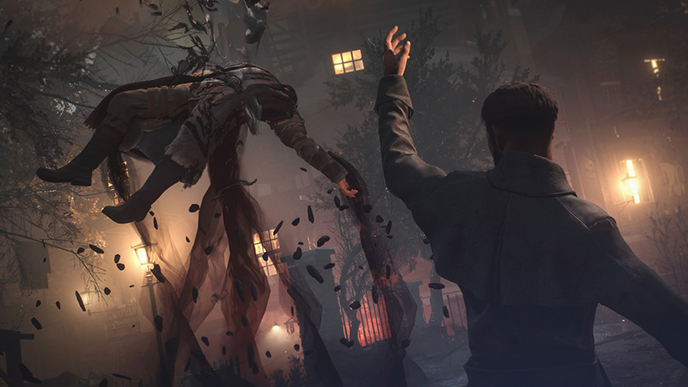
Vampyr is a confusingly designed game. It kind of had to be, given that it’s a game that doesn’t really have the financial backing of comparatively larger games, but is still trying to play ball in the same field as some other high-budget, narratively-focused titles.
While the writing of the game doesn’t lack in quantity, the quality is all over the place, and isn’t helped by the game’s macro-narrative (that is, the story that the game is trying to tell over its entire playtime) often coming into direct conflict with elements of its micro-narratives. The game’s ambitious undertaking of having an entire four boroughs of London populated by interactable characters, each with their own conversation trees, quests, and relations to other characters within their borough and in others, is commendable—but the tenuous relationships that inter-mission sections rely on are thrown out the window during key plot points, leaving me more frustrated and confused than I can recall being at a videogame in recent memory.
To put it more directly: Vampyr is kind of a mess, and at a certain point it was too much of a mess to continue playing, even for me. Even if I think some parts of it are great, a repeated sense that the game was punishing me for attempting to engage with its narrative choices eventually became too much to bear.
Warning: I’m going to get pretty detailed here, so if you’re worried about spoilers I’d duck out now.
For a specific example, it’s useful to look at the way the game uses Pillars of each borough. Each of the four boroughs of London represented in Vampyr (Whitechapel, The Docks, West End, and the Pembroke Hospital) contain several citizens as well as a Pillar of the community, around whom the rest of the borough is organized.
In Whitechapel, you discover that the Pillar is a nurse from your own Pembroke Hospital. The nurse, Dorothy Crane, is running a free clinic in Whitechapel, servicing those too afraid to enter the more prestigious Pembroke Hospital. Dorothy Crane, it is revealed, is an immigrant and an anarchist, who fled her home in the Ukraine after the events of World War I.
You come to find out that Nurse Crane is also blackmailing a prominent vampire at the Pembroke Hospital in exchange for resources and secrecy. When the vampire calls for a stop to the blackmailing, you, as the player, are offered a three-way choice: Either kill Crane outright, spare Crane and trust that she will stop the blackmail, or use your vampiric abilities to make her forget.
This is where things get frustrating. There is little indication given to the player that “charming” Crane will lead to her abandoning her clinic. It is framed, in conversations, as a way to make her forget about the vampire at Pembroke, not about the state of her clinic. Believing it to be the most humane answer to a complicated question, I chose to charm her.
At first, my choice appeared to be correct. She returned to her practice and spoke no more of the vampire at Pembroke. But after a night of rest, I was alerted in the game’s map screen that an “event” had occurred at her clinic. Making my way there, I found not only the entire district in disarray (its health dipped from “Healthy” to “Critical” overnight) but Crane herself turned into a Skal—a sort of vampire-zombie, most often seen without any use of their faculties, screaming and violent.
This scenario, once, could be forgiven. Sure, I didn’t expect it to happen, but sometimes that’s how games are. Sometimes things do come down to a single conversational choice, and you just have to pick the one that makes the most sense to you and move on.
The problem is that this wasn’t an isolated incident. A second district, later in the main storyline, has its Pillar turned Skal, but in this case the man is lucid and talkative. He is a priest, and by all accounts a trustworthy character, even going so far to pledge to only eat the flesh of the already-dead.
Like Crane, this character runs a free service for his community, a sort of refuge for the houseless. After he is turned Skal, the player understandably is wary, but after he introduces you to an underground society of peaceful Skals, it became clear what the implied narrative is. Though Skals may be terrifying, they are diverse just as people are. Some of them are pacifist, and have made peace with their condition.
After facing another three-way choice, I chose to spare the man, believing (as the game had repeatedly shown me) that he was trustworthy and mentally fortified, that Skals were misunderstood as monsters, and that his connections with the peaceful Skal society would insulate him from going rabid.
As you might expect from the previous story, things did not go down that path. Returning to the district some time later I found it in flames, some of its previous residents turned into hostile vampire hunters and others into Skals. As with Nurse Crane, I ended up dispatching a former friend after an inexplicable transformation from a friendly character to a hostile one.
Vampyr has these sort of conflicts strewn throughout its main storyline. Attempting to be compassionate using the lore and history of the world that has been presented to you is punished by characters dying for little to no explained reasons, and the game is more than equipped to throw you into yet another slog of a combat scene instead of any alternative to slaughtering a former ally.
The issue here isn’t that the design of the game is brutal—brutal narratives are fine, and have a place. The problem is that the narrative is not signaled to the player in a way that makes sense. Both choices I made with Pillars were communicated (either directly or indirectly) as the ones that would leave the districts in the most capable hands. In the case of the second Pillar described above, it was the choice that the character explicitly asked for—choosing any other method of dealing with them would have violated what their wishes were.
I have no problem with a game that asks me to make tough decisions—I relish those games—but Vampyr doesn’t give me “tough decisions.” It gives vague, handwavey forks in the road, and asks me to choose one, then punishes me for reasons that are unclear. It’s a disappointing and frustrating end to my time with the game.
Dante Douglas is a writer, poet and game developer. You can find him on Twitter at @videodante.

